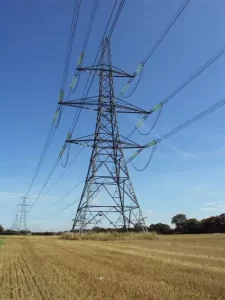British energy infrastructure faces significant challenges over the coming years, with the transition to renewables accelerating while the government applies increased pressure to reduce consumer costs.
The national grid is key to British energy infrastructure, allowing a seamless transmission of electricity long distances from where it is generated to where it is needed.
In this guide, we’ll learn more about this crucial infrastructure, the challenges ahead and how it affects the energy bills.
What is the National Grid?
The national grid is a high-voltage electric power transmission network across Great Britain.
The network uses high voltage cables that can transfer electricity long distances with only minor losses in power. The majority of the national grid is above ground, and you will surely have noticed these power cable structures:

The National Grid network connects the following:
Electricity interconnectors
Undersea cables that import electricity from surrounding countries. The national grid currently encompasses the following interconnectors:
- Northern Ireland to the Kintyre Penisula in Scotland
- The Republic of Ireland to Birkenhead
- France to Dover, Kent
- Belgium to Sandwick, Kent
- The Netherlands to the Isle of Sheppy
Additionally, the North Sea Link is currently under construction and will connect Northumbria with Norway. The planned cable will be the longest undersea cable in the world and will have the capacity to power 1.4 million homes.
British power stations
Power stations generate electricity. The National Grid moves the electricity generated from the power stations to where it is needed.
In Britain, the national grid connects to the highest capacity power generators:
- Wind Farms – Both onshore and offshore across the country
- Gas-Fired Power Stations – Located across the country
- Nuclear Power Plants – In several locations on the coastline
Regional Network operators
Distribution network operators are regional network grid operators that connect the national grid to individual homes and businesses. These regional networks transport electricity at a lower voltage over shorter distances.
Using the roads as an analogy, the national grid is the motorway network, the distribution network operators are dual carriageways, and Independent Operators are local roads.
Find out more in our guide to the regional network operators.
The history of the National Grid
Prior to the 20th century, the UK power network consisted of a patchwork of regional supply networks. Small networks each required their own source of power, making them highly inefficient. In a connected network, surplus power in one area can be used by an area experiencing shortages.
It took until 1938 for the National Grid to be created, consisting of 4,000 miles of overhead cables connecting the country’s 122 highest output power stations. The new grid proved its worth during the Blitz, where shortages in London caused by the damaged Battersea Power Station were substituted with electricity generated in South Wales.
In the proceeding eighty years, the grid has been continually expanded and improved as the energy needs of Britain changed over time.
Who owns the National Grid?
The National Grid is owned by National Grid Plc, a multinational electricity and gas utility company headquartered in London.
National Grid Plc owns several electricity and gas network assets across the UK and the US. As of July 2022, National Grid Plc had a market capitalisation of £40 billion.
How does the National Grid work?
The national grid efficiently moves electricity around the country using high voltage cables. Transformers convert generated electricity up to 400,000 volts.
High Voltage electricity has the property of being able to move long distances along cables with only minor losses of power.
Most of the national grid uses electricity pylons to safely isolate the high-voltage cables from roads, railway lines and people.
What is the future of the National Grid?
The two biggest challenges facing the National Grid are the UK’s transition to renewable energy and the cost crisis facing electricity users.
Let’s look at each in turn:
The UK’s net-zero transition
The UK is committed to achieving net-zero carbon emissions by 2050. A crucial part of the plan is to reduce the UK’s reliance on fossil fuels by increasing green energy capacity.
The transition to renewable energy changes the requirements for the national grid, in particular by adapting the network to connect directly to new sources of low carbon and green energy.
Cost reduction
In 2022, the cost of electricity and gas skyrocketed. Ofgem, the energy regulator and the government, are focused on driving down costs to tame inflation.
The regulator plans to deliver cost reductions by pushing network operators, including National Grid Plc, to deliver a more efficient service. Learn more about Ofgem’s plans here.
Get the latest energy prices today with AquaSwitch with our:

